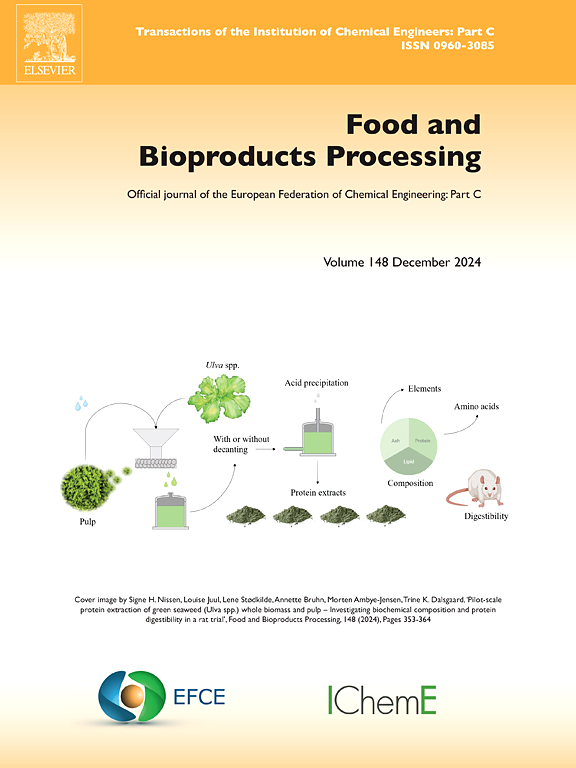Particle impact in high-pressure homogenizer valves – A step towards understanding wear and cell breakup in food and beverage processing
IF 3.5
2区 农林科学
Q2 BIOTECHNOLOGY & APPLIED MICROBIOLOGY
引用次数: 0
Abstract
In many liquid food processing applications using high-pressure homogenizers (HPHs), particles impact with the solid surfaces of the homogenization device. This may lead to costly wear. For some applications, impact is also postulated to control the desired cell disruption. This contribution uses computational fluid dynamics to study impact of particles on solid surfaces in HPHs, as a step towards design optimization. Effects of particle diameter, density, homogenizing pressure, and impact distance are studied. Results show impacts both on the forcer and on the impingement ring. Few particles hit the forcer, at low velocities and with low angles (‘bracing impacts’). More particles hit the impact ring. These impacts are with higher velocities and typically occur head-on. The effect of both homogenizing pressure and impact ring distance scales according to a previously suggested stagnation pressure model. Results are discussed in the light of wear and cell disruption observations.
高压均质机阀门中的颗粒影响--了解食品和饮料加工过程中的磨损和细胞破碎的一个步骤
在许多使用高压均质机(HPH)的液态食品加工应用中,颗粒会撞击均质装置的固体表面。这可能会导致昂贵的磨损。在某些应用中,撞击还被认为可以控制所需的细胞破坏。本文利用计算流体动力学研究了颗粒对高压均质装置中固体表面的影响,以此作为优化设计的一个步骤。研究了颗粒直径、密度、均质压力和冲击距离的影响。结果表明,颗粒既会撞击锻造器,也会撞击撞击环。很少有颗粒以低速和低角度("支撑撞击")撞击锻造器。撞击环的颗粒较多。这些撞击速度较高,通常是正面撞击。匀化压力和撞击环距离的影响根据之前提出的停滞压力模型进行缩放。根据磨损和细胞破坏观察结果对结果进行了讨论。
本文章由计算机程序翻译,如有差异,请以英文原文为准。
求助全文
约1分钟内获得全文
求助全文
来源期刊

Food and Bioproducts Processing
工程技术-工程:化工
CiteScore
9.70
自引率
4.30%
发文量
115
审稿时长
24 days
期刊介绍:
Official Journal of the European Federation of Chemical Engineering:
Part C
FBP aims to be the principal international journal for publication of high quality, original papers in the branches of engineering and science dedicated to the safe processing of biological products. It is the only journal to exploit the synergy between biotechnology, bioprocessing and food engineering.
Papers showing how research results can be used in engineering design, and accounts of experimental or theoretical research work bringing new perspectives to established principles, highlighting unsolved problems or indicating directions for future research, are particularly welcome. Contributions that deal with new developments in equipment or processes and that can be given quantitative expression are encouraged. The journal is especially interested in papers that extend the boundaries of food and bioproducts processing.
The journal has a strong emphasis on the interface between engineering and food or bioproducts. Papers that are not likely to be published are those:
• Primarily concerned with food formulation
• That use experimental design techniques to obtain response surfaces but gain little insight from them
• That are empirical and ignore established mechanistic models, e.g., empirical drying curves
• That are primarily concerned about sensory evaluation and colour
• Concern the extraction, encapsulation and/or antioxidant activity of a specific biological material without providing insight that could be applied to a similar but different material,
• Containing only chemical analyses of biological materials.
 求助内容:
求助内容: 应助结果提醒方式:
应助结果提醒方式:


